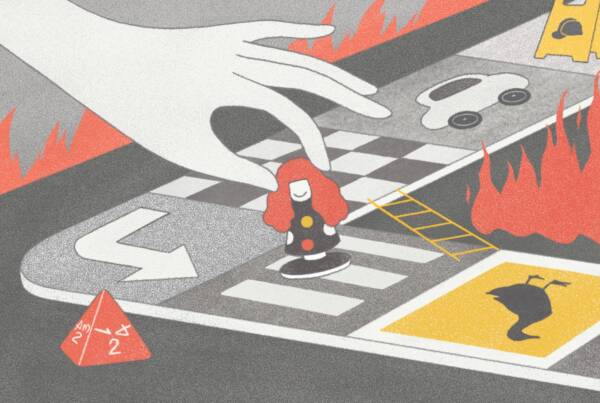Writing by Hannah Forsdike // Illustration by Sofie Birkin // My hope here is to encourage you to rethink about your relationship with fashion to help save this beautiful planet we are lucky enough to call home.
Writing by Hannah Forsdike // Illustration by Sofie Birkin
Have you ever thought about what happens to your old clothing? That outfit you bought for that one event and never wore again? Or those cheap pyjamas that fell apart or shrunk after just a few washes? Where do you think they are now? The reality is that they are more than likely in a landfill. Even if you donate your old clothes to charity, donations that can’t be sold are vetted and the majority of clothing that gets donated still ends up in landfill one way or another.
Fast fashion allows us to buy stylish new clothes for pocket change. There are hours and hours worth of haul videos on YouTube of Bikinis for under $12 and other inexpensive fast fashion finds. This industry encourages us to buy far too many clothes, more than we really need. And most of the clothing that these companies turn over are such low quality they would barely survive more than a season of use anyway. You might have thought your wallet was taking the toll for these ever changing trends and a culture that normalises treating clothing like Kleenex, but the real victim here is our Earth.
Remember when you were in school, with your feet up on the desk and your teacher would try to get you to take your feet down by asking, ‘would you treat your home like this?’ and you would say, ‘hell yes I would!’ Because you were a kid and you didn’t have a very strong concept of money and the value of things, which lead to a lack of respect for your parents furniture. Flash forward a few years and you’re living out of your parent’s house for the first time. You’ve spent your whole paycheck on furniture, and suddenly you become really anal retentive about using coasters because if you were to get a coffee mug stain on that $30 chipboard bedside table you would probably cry. Well, our Earth needs us to start using some metaphorical coasters, we’ve abused it carelessly for long enough. This planet is our home, it’s the only one we have. And although it is heartbreakingly poetic that we’re slowly destroying that which keeps us alive, some things have to change. For me personally, I knew I needed to make a big change to my relationship with clothing.
I once loved fast fashion. When I was at university working a casual job, I loved that I could afford to buy new clothes almost every week. I had so many clothes I could hardly shut the door to my wardrobe. I’d buy new items for mildly special occasions, with little thought or care as to whether I would ever wear them again.
The appeal of fast fashion is so popular it manages to eclipse the harm it causes. From the environmentally harmful and unethical production measures necessary to produce so much clothing so quickly, to the impact textile waste has on our environment, it’s time to for a harsh reality check on the real cost of cheap clothes.
So why can’t we just recycle our old clothes into new clothes? Most clothing, particularly clothing turned out by the fast fashion industry, is made of blended fibre’s that can’t easily be broken down and reused. The reality is that textile recycling is still in its very early stages. I truly hope we get there one day, but at the moment, it just isn’t a solution.
If the industry can’t help and recycling efforts aren’t effective, what is the solution? What can we do on an individual level? I have a few ideas.
Stop buying so much…
The first and most obvious solution is to reduce your impact: stop buying so much clothing! I know this is easier said than done, as someone who was a total sucker for fast fashion, I know this can be hard adjustment to make. Next time you have an event that you’d usually buy a new outfit for, look in your wardrobe first and wear something you already own.
The thirty wears system…
I can’t remember where I first heard about this, but I try to apply it to every purchase. It’s a simple shopping strategy: if you aren’t going to wear something a minimum of 30 times, don’t buy it. This encourages people to buy diverse, good quality pieces, which leads nicely into our next point.
Shop smart…
When you do buy clothes, shop carefully. Buy good quality clothing that will last a long time. I know it seems expensive, but if you add up all the money you’re spending on lots of low quality pieces, buying one high quality piece doesn’t seem so scary. As well as high quality, make sure the items you buy are diverse, so you can get a lot of wear out of them. I try to look for clothes that I can wear across seasons, and items I can dress up or down easily. This means you’ll need less clothing, which ultimately means less waste going into landfills.
Change where you shop…
Instead of buying from big fashion companies, why not support local and environmentally friendly brands. These clothes are often high quality and you’ll be helping to support people that are working to fight fast fashion. Reducing support to big companies will also help alter the demand for cheap, expendable clothing. If you can’t always afford to shop ethical brands, buy second hand! Check out the opportunity stores in your area or jump online, there is a huge online marketplace for second hand clothing on Facebook and Depop. Reusing is the most effective way of recycling clothes.
Find creative ways to recycle your clothes…
We know that most of the clothes you donate will likely end up in landfill anyway, so come up with more creative solutions for clothes you don’t wear anymore. You could have a clothing swap party with your friends; everyone brings all their unwanted clothes for their friends to pick through. It’s kind of like thrifting, but for free!
You could try to alter clothes you don’t wear anymore. I have a beautiful maxi dress that I bought for a wedding once, but it’s just too fancy to get any practical wear out of. So, I’ve altered it to be a short casual dress, it’s far more wearable now and I’m planning to use the excess material to make a top out of. I’ve also started dying old white t-shirts that are discoloured and covered in stains so I can keep wearing them.
Donation is always a better alternative then throwing your clothes straight in the trash. If you do donate, be sure to do your research and donate to a reliable business or charity. These charities often have criteria for what they accept as donations, so you can avoid giving them anything that they will just throw out.
For more creative solutions, Pinterest has hundreds of thousands of DIYs utilising your old clothing.
My hope here is to encourage you to rethink about your relationship with fashion to help save this beautiful planet we are lucky enough to call home. In doing this, try to consider what else you can do to live a less environmentally impactful lifestyle.







